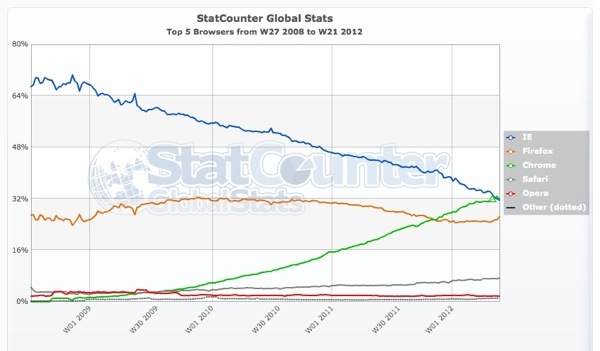I haven’t paid close attention to browser piecharts or percent usage spreadsheets since the late 1990s, when Microsoft and Netscape were slugging it out and some of us were still using Navigator’s “Netscape Composer” WYSIWYG HTML editor to cobble together rudimentary web pages (guilty as charged, and “rudimentary” would be a kindness). Internet Explorer has been tops pretty much since — distantly threatened by Firefox when Mozilla rolled it out in 2004, but holding the lion’s share of the market for what seems like eternity.
Until now — or, if we trust web traffic analysis outfit StatCounter’s numbers, until week 20 of 2012 (between May 14-20), when Google’s Chrome browser slipped ahead of Internet Explorer to grab the top global browser usage spot and hold it.
(MORE: Browser Wars on iOS? Seems Unlikely)
StatCounter’s figures date back to mid-2008, and if you sort by the total range, you can see the market dominated by Internet Explorer (over 65% usage) at the outset, with Firefox accounting for most of the remainder and everyone else (Chrome, Safari, Opera, etc.) barely registering. The story there forward is one of IE’s gradual decline to less than half of its mid-2008 audience, Firefox holding steady (averaging about 30%) and Google Chrome steadily rising from nothing (it was first released in September 2008) to surpass Internet Explorer just a few weeks ago.
While it’s not quite a double rainbow for Google — StatCounter showed the company’s Android Robot web browser briefly bypassed Opera as the most popular mobile web portal in February 2012, but it’s since surrendered that lead back to Opera — it illustrates how far the company’s come on both mobile and traditional platforms since starting from zero in late 2008.
Chrome technically slipped ahead of Internet Explorer for the first time back in March 2012, according to StatCounter, but only for a day. The two browsers have been dueling since, with IE narrowly leading. Last week was the first time Chrome moved into pole position and held the spot. Bear in mind that these numbers are only general indices of how usage is trending, not precise market measurements, and I’d wager the two browsers will trade places several times in the coming months — whether May registers as the first month Chrome reigns supreme remains to be seen.
Don’t worry, we won’t pester you with weekly updates of who’s on top, since the race is neck-and-neck (and looking to stay that way). That, and this sort of number nitpicking matters far less today than it did a decade ago. Many of us live in a multi-browser world anyway, running Safari and Chrome or IE and Firefox simultaneously, going to one for the things it does well while invoking the other when we need to access different features or a web page isn’t working. For instance, I use Safari the most because of the way it handles RSS bookmark updates (inline numbers next to the category, no funky plugins), but I’ll often load Chrome to counter a badly behaving page in Cupertino’s browser.
[via TheNextWeb]
MORE: Become Fluent with Language Immersion for Google Chrome


